参考链接:https://www.bilibili.com/video/BV1et411b73Zp=167&vd_source=b4d9cee68649c8adcb1e266f7147cd5c
一、模板
1.1 模板的概念
模板就是建立通用的模具,大大提高复用性
例如生活中的模板
一寸照片模板:

PPT模板:

模板的特点:
模板不可以直接使用,它只是一个框架
模板的通用并不是万能的
1.2 函数模板
C++另一种编程思想称为 泛型编程 ,主要利用的技术就是模板
C++提供两种模板机制:函数模板和类模板
1.2.1 函数模板语法
函数模板作用:
建立一个通用函数,其函数返回值类型和形参类型可以不具体制定,用一个虚拟的类型来代表。
语法:
template<typename T>
函数声明或定义
解释:
template — 声明创建模板
typename — 表面其后面的符号是一种数据类型,可以用class代替
T — 通用的数据类型,名称可以替换,通常为大写字母
实现两种类型的数交换
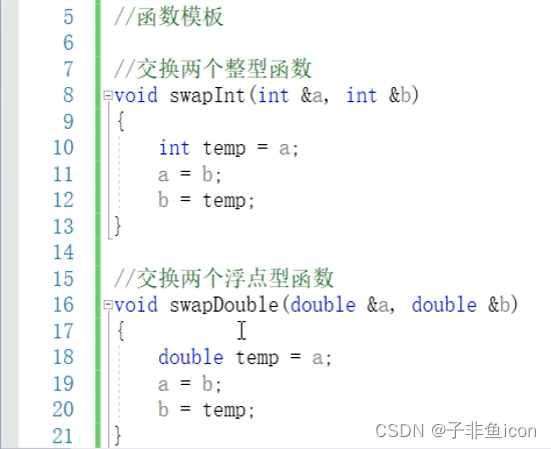
用函数模板可以将类型参数化。
demo1:
#include<iostream>
#include<string>
using namespace std;
//函数模板
template<typename T> //声明一个模板,告诉编译器后面代码紧跟着的T不要报错,T是一个通用数据类型
void mySwap(T& a, T& b)
{
T temp = a;
a = b;
b = temp;
}
int main()
{
int a = 10;
int b = 20;
//两种方式使函数模板
//1.自动类型推导
//mySwap(a, b);
//2.显示指定类型
mySwap<int>(a, b);
cout << "a = " << a << endl;
cout << "b = " << b << endl;
system("pause");
return 0;
}
a = 20
b = 10
总结:
函数模板利用关键字 template
使用函数模板有两种方式:自动类型推导、显示指定类型
模板的目的是为了提高复用性,将类型参数化
1.2.2 函数模板注意事项
注意事项
自动类型推导,必须推导出一致的数据类型T,才可以使用
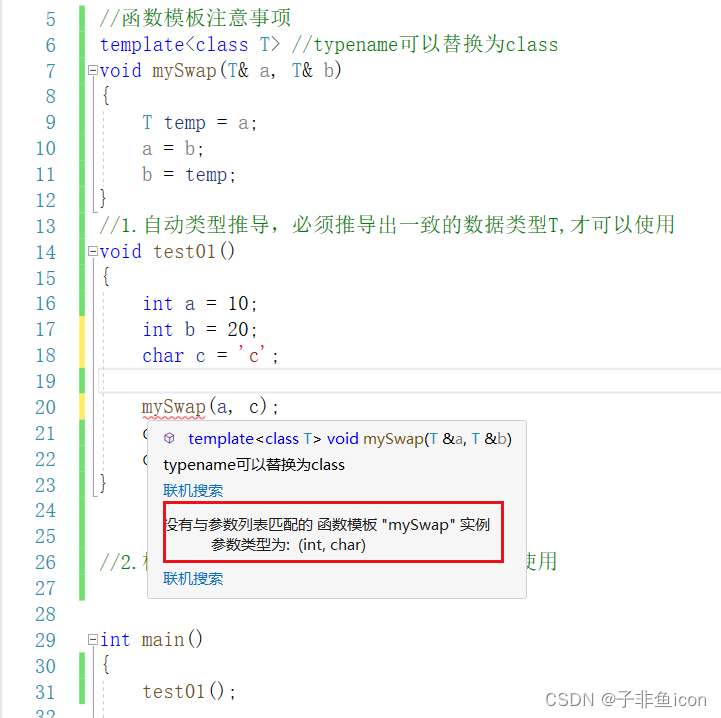
模板必须要确定出T的数据类型,才可以使用
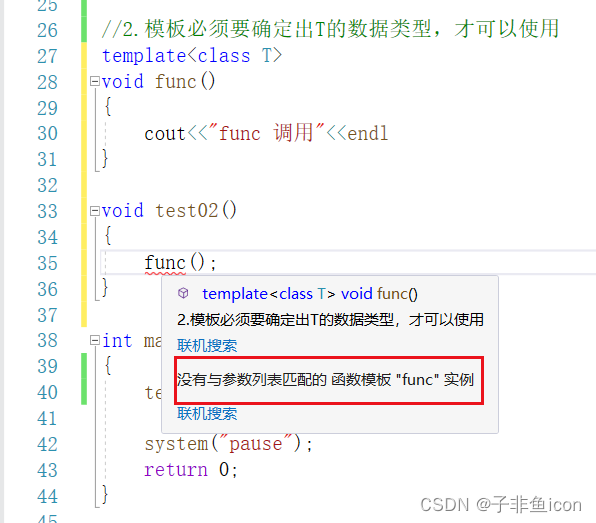
指定T的数据类型
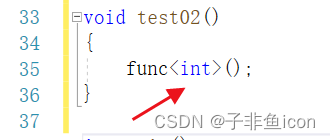
demo2:
#include<iostream>
#include<string>
using namespace std;
//函数模板注意事项
template<class T> //typename可以替换为class
void mySwap(T& a, T& b)
{
T temp = a;
a = b;
b = temp;
}
//1.自动类型推导,必须推导出一致的数据类型T,才可以使用
void test01()
{
int a = 10;
int b = 20;
char c = 'c';
//mySwap(a, c); //错误,推导不出一致的T类型
cout << "a = " << a << endl;
cout << "b = " << b << endl;
}
//2.模板必须要确定出T的数据类型,才可以使用
template<class T>
void func()
{
cout << "func 调用" << endl;
}
void test02()
{
func<int>();
}
int main()
{
test01();
test02();
system("pause");
return 0;
}
a = 10
b = 20
func 调用
总结
使用模板时必须确定出通用数据类型T,并且能够推导出一致的类型
1.2.3 函数模板案例
案例描述:
利用函数模板封装一个排序的函数,可以对不同数据类型数组进行排序
排序规则从大到小,排序算法为选择排序
分别利用char数组和int数组进行测试
demo3:
#include<iostream>
#include<string>
using namespace std;
//交换函数模板
template<class T> //typename可以替换为class
void mySwap(T& a, T& b)
{
T temp = a;
a = b;
b = temp;
}
//排序算法
template<class T>
void mySort(T arr[], int len)
{
for (int i = 0; i < len; i++)
{
int max = i; //认定最大值的下标
for (int j = i + 1; j < len; j++)
{
//认定的最大值比遍历出的数值要小,说明j下标的元素才是真正的最大值
if (arr[max] < arr[j])
{
max = j; //更新最大值下标
}
}
if (max != i)
{
//交换max和i元素
mySwap(arr[max], arr[i]);
}
}
}
//提供打印数组的模板
template<class T>
void printArray(T arr[], int len)
{
for (int i = 0; i < len; i++)
{
cout << arr[i] << " ";
}
cout << endl;
}
void test01()
{
//测试char数组
char charArr[] = "badcfe";
int num = sizeof(charArr) / sizeof(char);
mySort(charArr, num);
printArray(charArr, num);
}
void test02()
{
//测试int数组
int intArr[] = {7,5,1,3,9,2,4,6,8};
int num = sizeof(intArr) / sizeof(int);
mySort(intArr, num);
printArray(intArr, num);
}
int main()
{
test01();
test02();
system("pause");
return 0;
}
f e d c b a
9 8 7 6 5 4 3 2 1
1.2.4 普通函数与函数模板的区别
普通函数与函数模板区别:
普通函数调用时可以发生自动类型转换(隐式类型转换)
函数模板调用时,如果利用自动类型推导,不会发生隐式类型转换

如果利用显示指定类型的方式,可以发生隐式类型转换
demo4:
#include<iostream>
#include<string>
using namespace std;
//普通函数与函数模板区别
//1.普通函数调用时可以发生自动类型转换(隐式类型转换)
//2.函数模板调用时,如果利用自动类型推导,不会发生隐式类型转换
//3.如果利用显示指定类型的方式,可以发生隐式类型转换
//普通函数
int myAdd01(int a, int b)
{
return a + b;
}
//函数模板
template<class T>
T myAdd02(T a, T b)
{
return a + b;
}
void test01()
{
int a = 10;
int b = 20;
char c = 'c'; //ASCII码 a-97 c-99
cout << myAdd01(a, c) << endl;
//自动类型推导
//cout << myAdd02(a, c) << endl;
//显式指定类型
cout << myAdd02<int>(a, c) << endl;
}
int main()
{
test01();
system("pause");
return 0;
}
109
109
总结:建议使用显示指定类型的方式,调用函数模板,因为可以自己确定通用类型T
1.2.5 普通函数与函数模板的调用规则
调用规则如下:
- 如果函数模板和普通函数都可以实现,优先调用普通函数
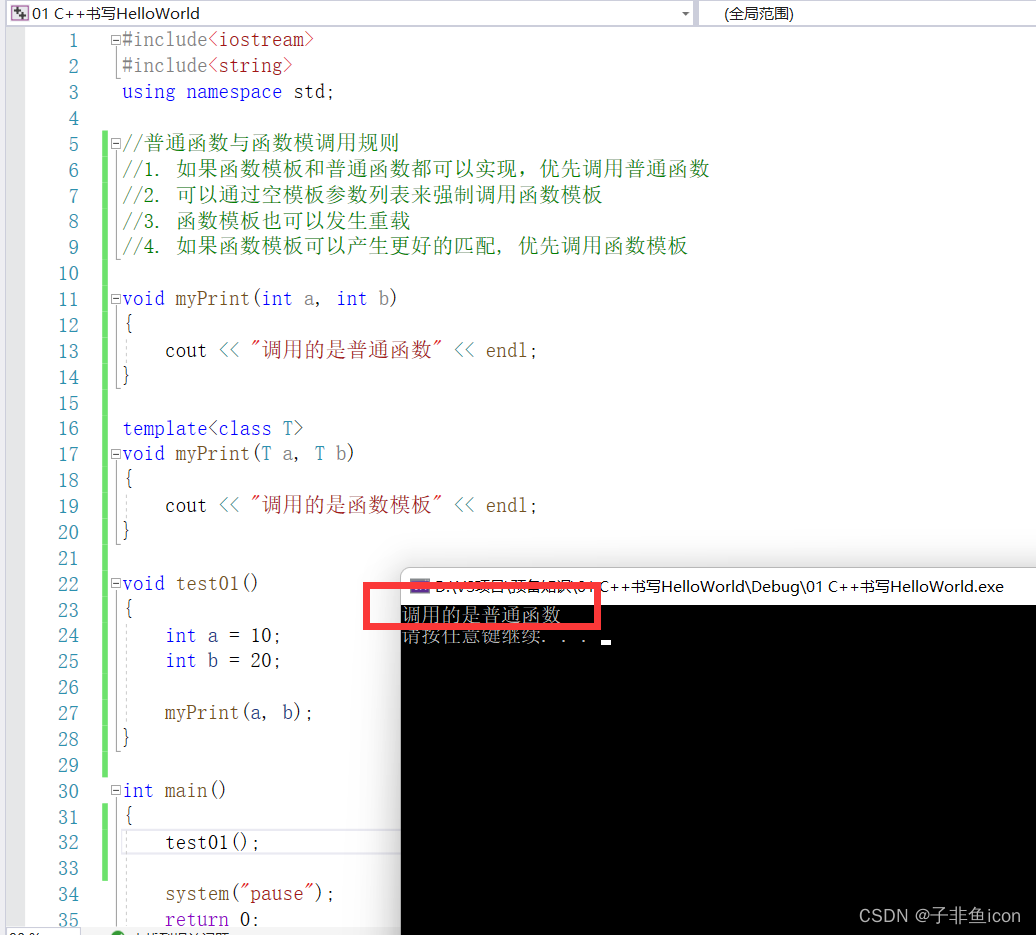
- 可以通过空模板参数列表来强制调用函数模板

- 函数模板也可以发生重载
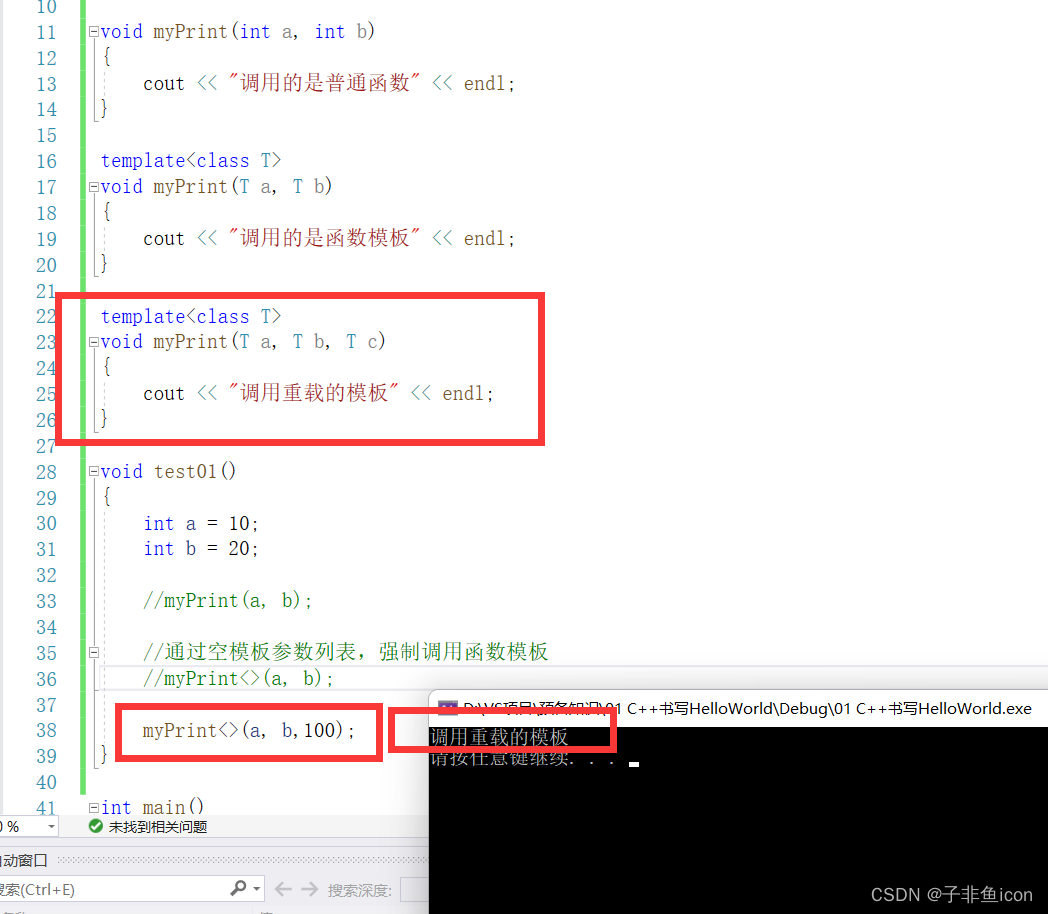
- 如果函数模板可以产生更好的匹配,优先调用函数模板
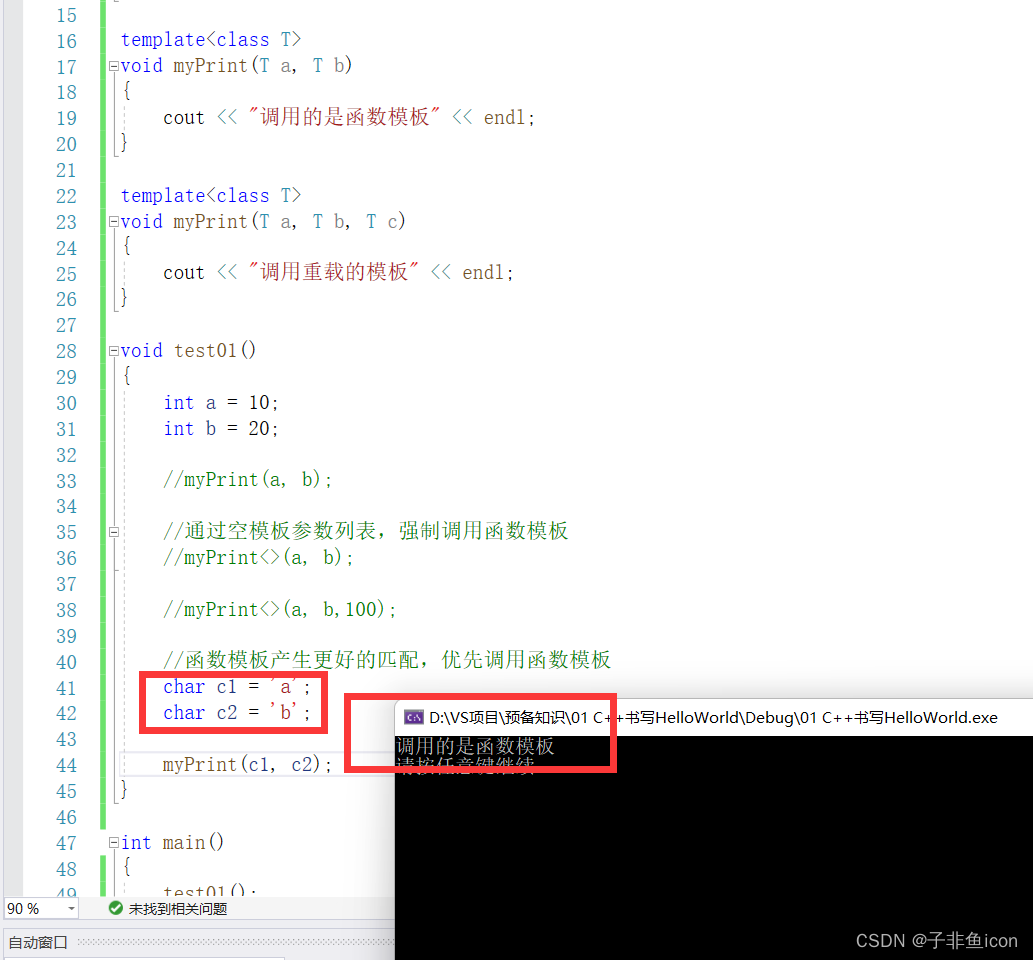
demo5:
#include<iostream>
#include<string>
using namespace std;
//普通函数与函数模调用规则
//1. 如果函数模板和普通函数都可以实现,优先调用普通函数
//2. 可以通过空模板参数列表来强制调用函数模板
//3. 函数模板也可以发生重载
//4. 如果函数模板可以产生更好的匹配, 优先调用函数模板
void myPrint(int a, int b)
{
cout << "调用的是普通函数" << endl;
}
template<class T>
void myPrint(T a, T b)
{
cout << "调用的是函数模板" << endl;
}
template<class T>
void myPrint(T a, T b, T c)
{
cout << "调用重载的模板" << endl;
}
void test01()
{
int a = 10;
int b = 20;
//myPrint(a, b);
//通过空模板参数列表,强制调用函数模板
//myPrint<>(a, b);
//myPrint<>(a, b,100);
//函数模板产生更好的匹配,优先调用函数模板
char c1 = 'a';
char c2 = 'b';
myPrint(c1, c2);
}
int main()
{
test01();
system("pause");
return 0;
}
总结:既然提供了函数模板,最好就不要提供普通函数,否则容易出现二义性
1.2.6 模板的局限性
局限性:
模板的通用性并不是万能的
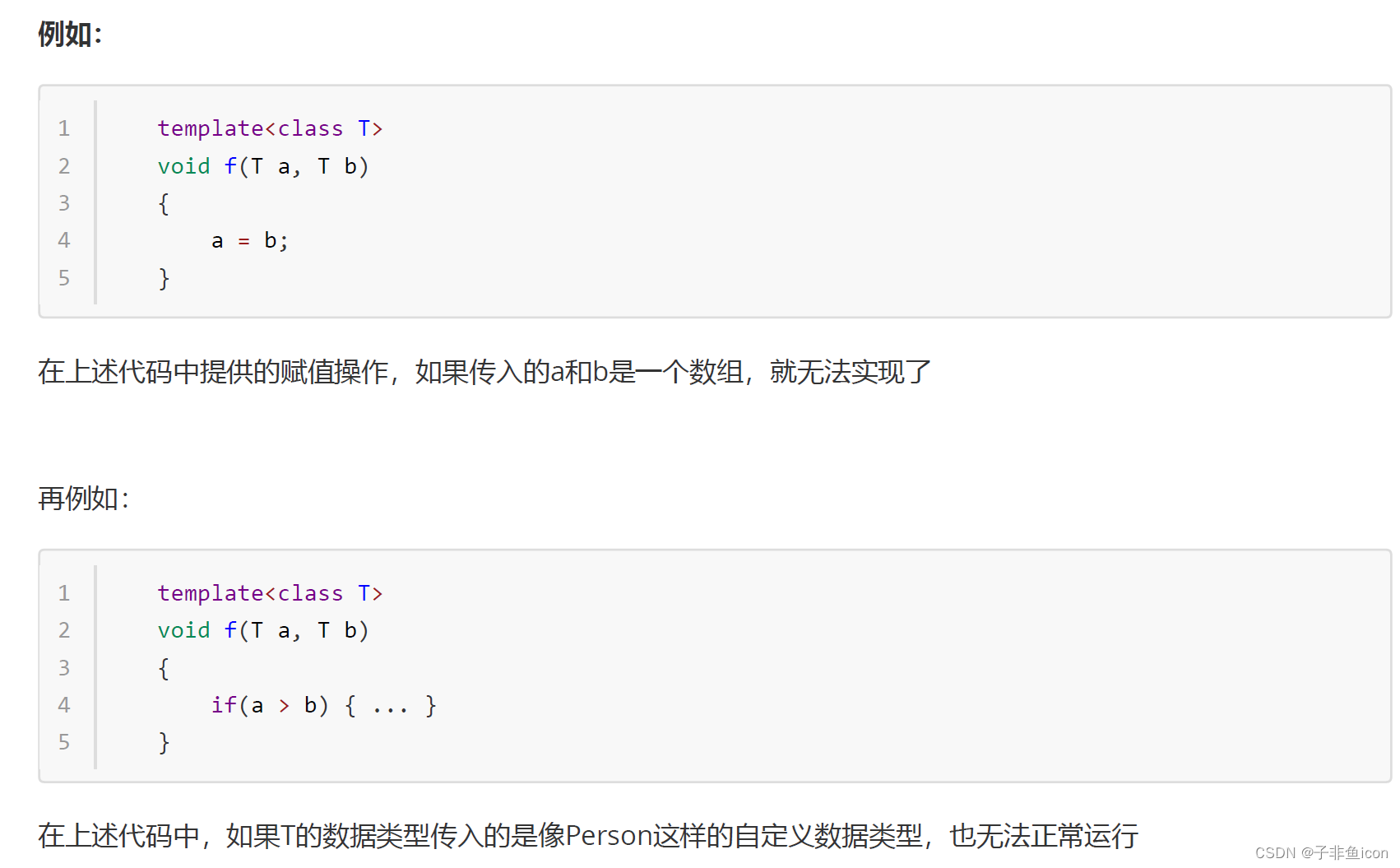
因此C++为了解决这种问题,提供模板的重载,可以为这些特定的类型提供具体化的模板
出现问题:
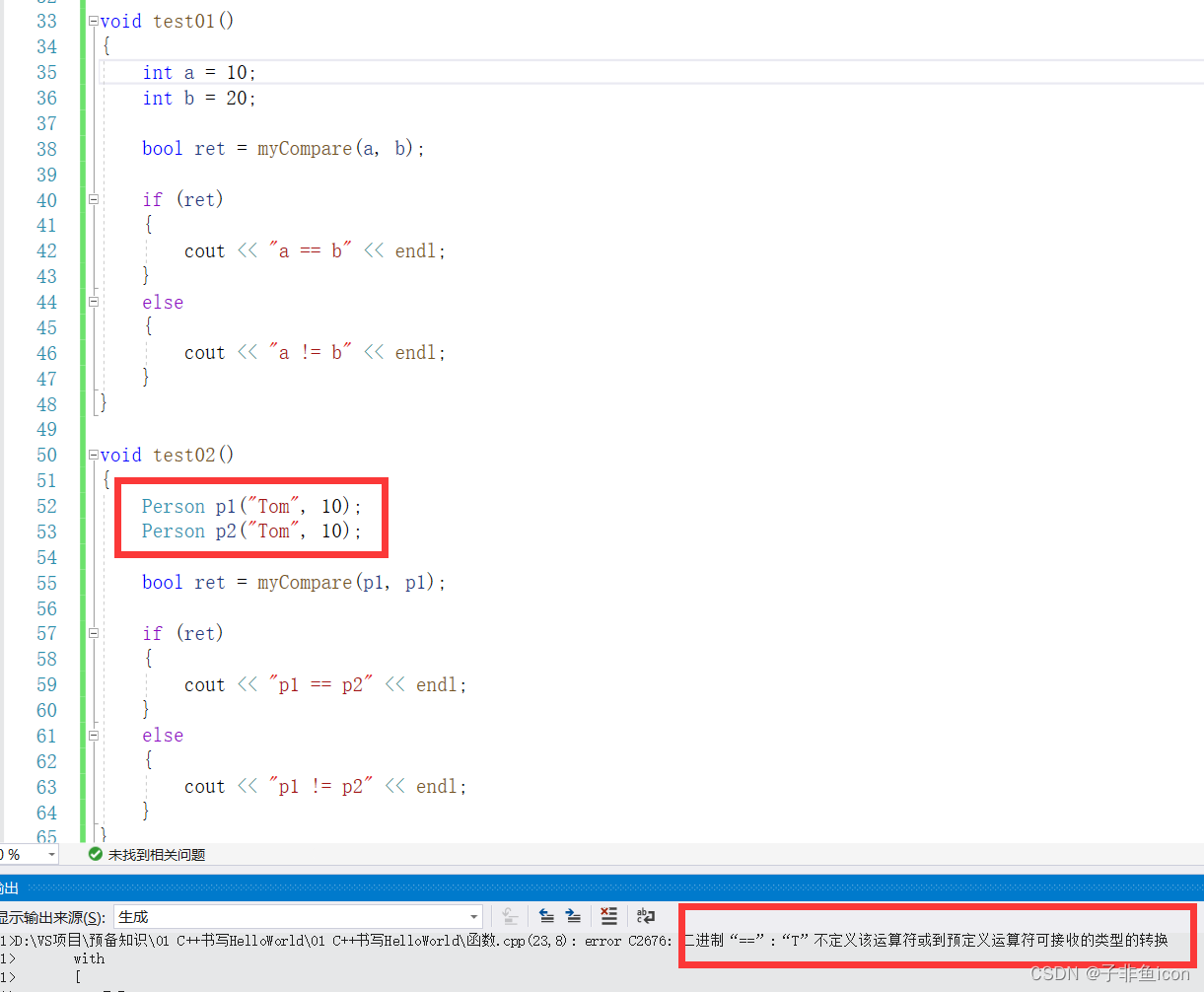
demo6:
#include<iostream>
#include<string>
using namespace std;
//模板局限性
class Person
{
public:
Person(string name, int age)
{
this->m_Name = name;
this->m_Age = age;
}
string m_Name;
int m_Age;
};
//对比两个数是否相等
template<typename T>
bool myCompare(T& a, T& b)
{
if (a == b)
{
return true;
}
else
{
return false;
}
}
//利用具体化Pesrson的版本实现代码,具体化优先调用
template<>bool myCompare(Person& p1, Person& p2)
{
if (p1.m_Name == p2.m_Name && p1.m_Age == p2.m_Age)
{
return true;
}
else
{
return false;
}
}
void test01()
{
int a = 10;
int b = 20;
bool ret = myCompare(a, b);
if (ret)
{
cout << "a == b" << endl;
}
else
{
cout << "a != b" << endl;
}
}
p1=p2
总结:
利用具体化的模板,可以解决自定义类型的通用化
学习模板并不是为了写模板,而是在STL能够运用系统提供的模板
1.3 类模板
1.3.1 类模板语法
类模板作用:
建立一个通用类,类中的成员 数据类型可以不具体制定,用一个虚拟的类型来代表。

demo7:
#include<iostream>
#include<string>
using namespace std;
//类模板
template<class NameType, class AgeType>
class Person
{
public:
Person(NameType name, AgeType age)
{
this->m_Name = name;
this->m_Age = age;
}
void showPerson()
{
cout << "name: " << this->m_Name << " age: " << this->m_Age << endl;
}
NameType m_Name;
AgeType m_Age;
};
void test01()
{
Person <string,int>p1("Tom", 10);
p1.showPerson();
}
int main()
{
test01();
system("pause");
return 0;
}
name: Tom age: 10
总结:类模板和函数模板语法相似,在声明模板template后面加类,此类称为类模板
1.3.2 类模板与函数模板区别
类模板与函数模板区别主要有两点:
- 类模板没有自动类型推导的使用方式
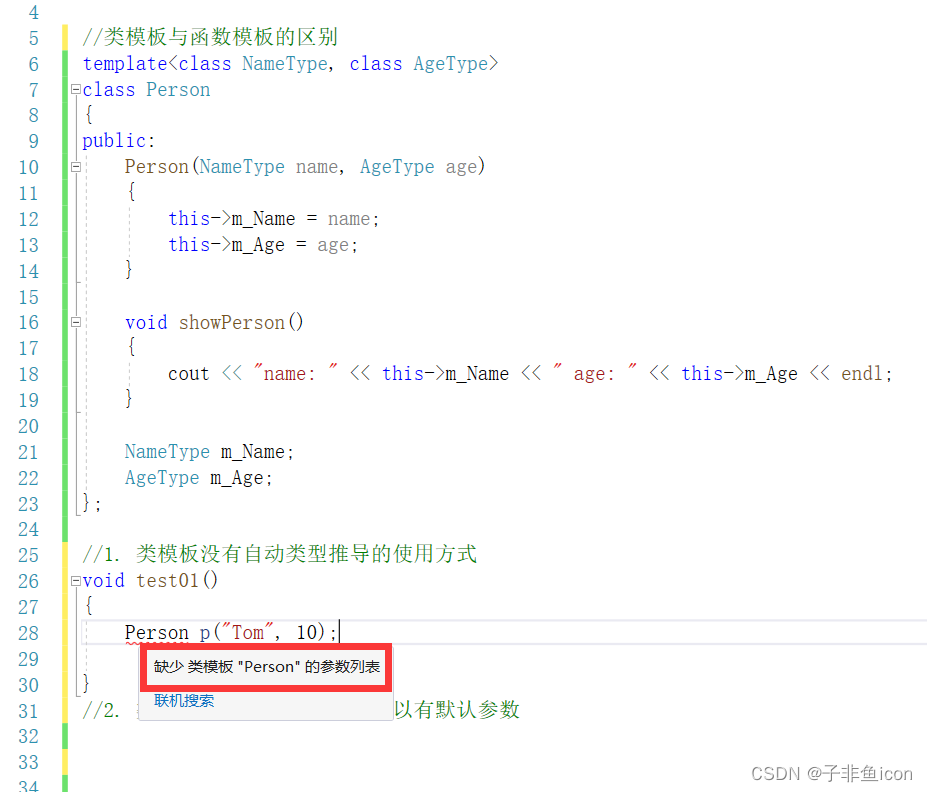
- 类模板在模板参数列表中可以有默认参数
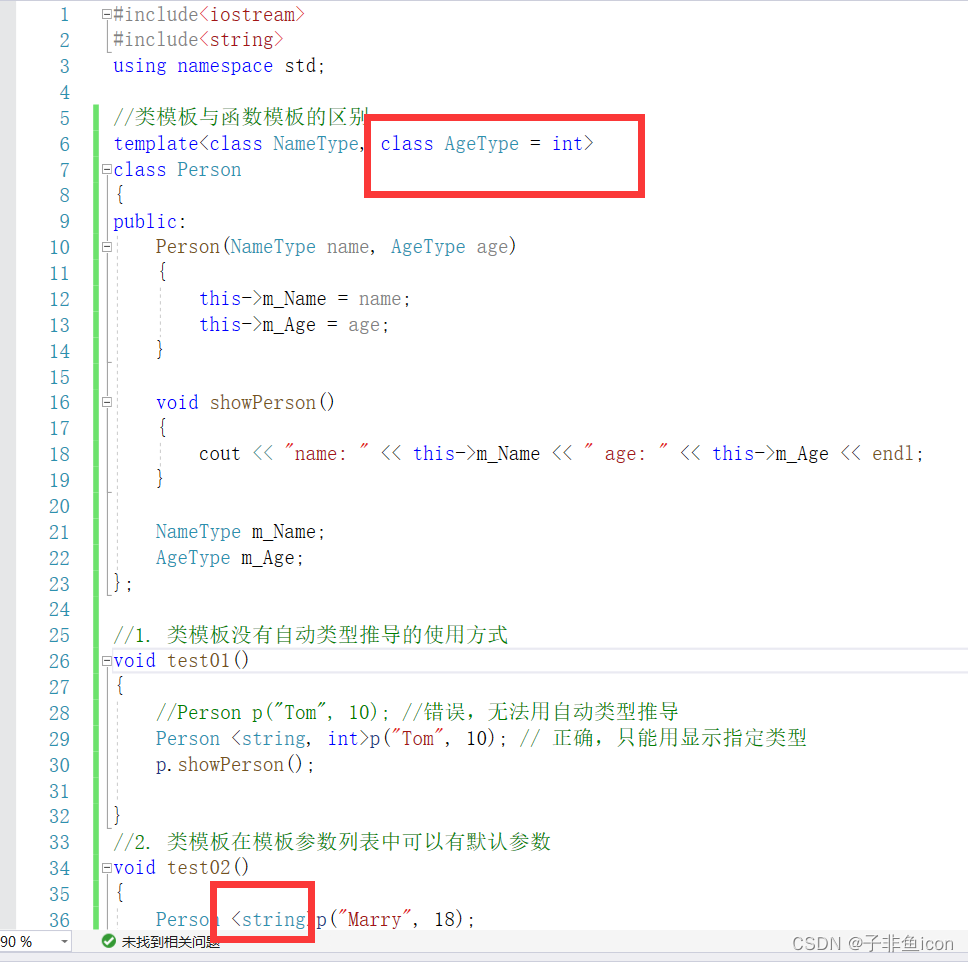
demo8:
#include<iostream>
#include<string>
using namespace std;
//类模板与函数模板的区别
template<class NameType, class AgeType = int>
class Person
{
public:
Person(NameType name, AgeType age)
{
this->m_Name = name;
this->m_Age = age;
}
void showPerson()
{
cout << "name: " << this->m_Name << " age: " << this->m_Age << endl;
}
NameType m_Name;
AgeType m_Age;
};
//1. 类模板没有自动类型推导的使用方式
void test01()
{
//Person p("Tom", 10); //错误,无法用自动类型推导
Person <string, int>p("Tom", 10); // 正确,只能用显示指定类型
p.showPerson();
}
//2. 类模板在模板参数列表中可以有默认参数
void test02()
{
Person <string>p("Marry", 18);
p.showPerson();
}
int main()
{
//test01();
test02();
system("pause");
return 0;
}
name: Marry age: 18
总结:
类模板使用只能用显示指定类型方式
类模板中的模板参数列表可以有默认参数
1.3.3 类模板中成员函数创建时机
类模板中成员函数和普通类中成员函数创建时机是有区别的:
普通类中的成员函数一开始就可以创建
类模板中的成员函数在调用时才创建
demo9:
#include<iostream>
#include<string>
using namespace std;
//类模板中成员函数创建时机
//类模板中成员函数在调用时才去创建
class Person1
{
public:
void showPerson1()
{
cout << "Person1 show" << endl;
}
};
class Person2
{
public:
void showPerson2()
{
cout << "Person2 show" << endl;
}
};
template<class T>
class MyClass
{
public:
T obj;
//类模板中的成员函数
void func1()
{
obj.showPerson1();
}
void func2()
{
obj.showPerson2();
}
};
void test01()
{
MyClass<Person1>m;
m.func1();
//m.func2();
}
int main()
{
test01();
system("pause");
return 0;
}
Person1 show
总结:类模板中的成员函数并不是一开始就创建的,在调用时才去创建
1.3.4 类模板对象做函数参数
学习目标:
类模板实例化出的对象,向函数传参的方式
一共有三种传入方式:
- 指定传入的类型 — 直接显示对象的数据类型
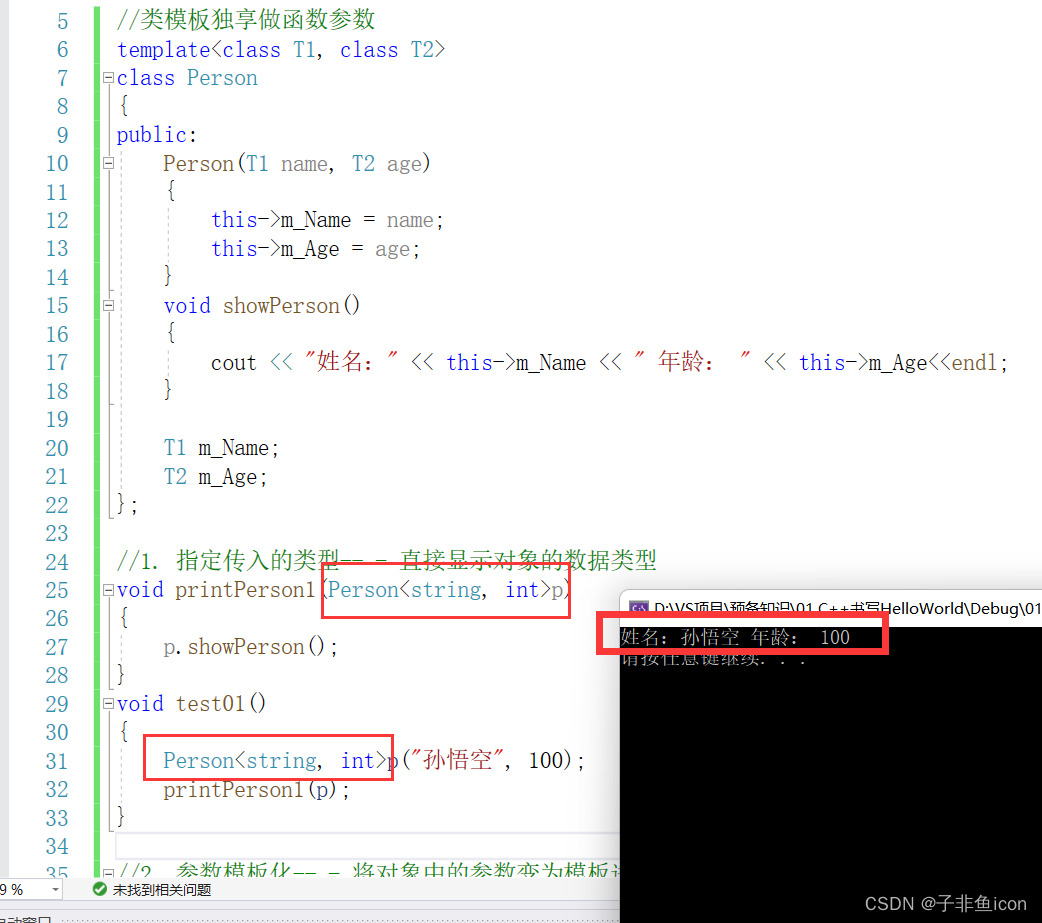
- 参数模板化 — 将对象中的参数变为模板进行传递


- 整个类模板化 — 将这个对象类型 模板化进行传递

demo10:
#include<iostream>
#include<string>
using namespace std;
//类模板独享做函数参数
template<class T1, class T2>
class Person
{
public:
Person(T1 name, T2 age)
{
this->m_Name = name;
this->m_Age = age;
}
void showPerson()
{
cout << "姓名:" << this->m_Name << " 年龄: " << this->m_Age<<endl;
}
T1 m_Name;
T2 m_Age;
};
//1. 指定传入的类型-- - 直接显示对象的数据类型
void printPerson1(Person<string, int>p)
{
p.showPerson();
}
void test01()
{
Person<string, int>p("孙悟空", 100);
printPerson1(p);
}
//2. 参数模板化-- - 将对象中的参数变为模板进行传递
template<class T1, class T2>
void printPerson2(Person<T1, T2>p)
{
p.showPerson();
cout << "T1的类型为:" << typeid(T1).name() << endl;
cout << "T2的类型为:" << typeid(T2).name() << endl;
}
void test02()
{
Person<string, int>p("猪八戒", 90);
printPerson2(p);
}
//3. 整个类模板化-- - 将这个对象类型 模板化进行传递
template<class T>
void printPerson3(T &p)
{
p.showPerson();
cout << "T的类型为:" << typeid(T).name() << endl;
}
void test03()
{
Person<string, int>p("唐僧", 30);
printPerson3(p);
}
int main()
{
//test01();
//test02();
test03();
system("pause");
return 0;
}
总结:
通过类模板创建的对象,可以有三种方式向函数中进行传参
使用比较广泛是第一种:指定传入的类型
1.3.5 类模板与继承
当类模板碰到继承时,需要注意一下几点:
当子类继承的父类是一个类模板时,子类在声明的时候,要指定出父类中T的类型
如果不指定,编译器无法给子类分配内存
如果想灵活指定出父类中T的类型,子类也需变为类模板
demo11:
#include<iostream>
#include<string>
using namespace std;
//类模板与继承
template<class T>
class Base
{
T m;
};
//class Son :public Base //错误,必须要知道父类中的T类型,才能继承给子类
class Son :public Base<int>
{
};
void test01()
{
Son s1;
}
//如果想灵活指定父类中T类型,子类也需要变类模板
template<class T1,class T2>
class Son2 :public Base<T2>
{
public:
Son2()
{
cout << "T1的类型为:" << typeid(T1).name() << endl;
cout << "T2的类型为:" << typeid(T2).name() << endl;
}
T1 obj;
};
void test02()
{
Son2 <int,char>s2;
}
int main()
{
test01();
test02();
system("pause");
return 0;
}
T1的类型为:int
T2的类型为:char
总结:如果父类是类模板,子类需要指定出父类中T的数据类型
1.3.6 类模板成员函数类外实现
学习目标:能够掌握类模板中的成员函数类外实现
demo12:
#include<iostream>
#include<string>
using namespace std;
//类外模板成员函数类外实现
template<class T1, class T2>
class Person
{
public:
Person(T1 name, T2 age);
//{
// this->m_Name = name;
// this->m_Age = age;
//}
void showPerson();
//{
// cout << "姓名:" << this->m_Name << " 年龄: " << this->m_Age << endl;
//}
T1 m_Name;
T2 m_Age;
};
//构造函数的类外实现
template<class T1, class T2>
Person<T1,T2>::Person(T1 name, T2 age)
{
this->m_Name = name;
this->m_Age = age;
}
//成员函数的类外实现
template<class T1, class T2>
void Person<T1, T2>::showPerson()
{
cout << "姓名:" << this->m_Name << " 年龄: " << this->m_Age << endl;
}
void test01()
{
Person<string, int>p("Tom", 20);
p.showPerson();
}
int main()
{
test01();
system("pause");
return 0;
}
姓名:Tom 年龄: 20
总结:类模板中成员函数类外实现时,需要加上模板参数列表
1.3.7 类模板分文件编写
学习目标:
掌握类模板成员函数分文件编写产生的问题以及解决方式
问题:
类模板中成员函数创建时机是在调用阶段,导致分文件编写时链接不到
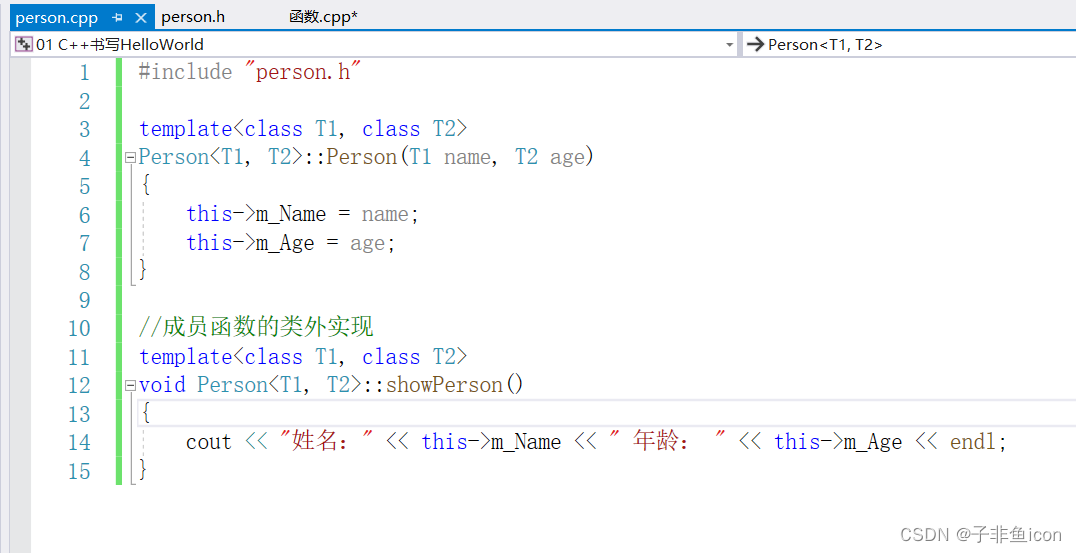

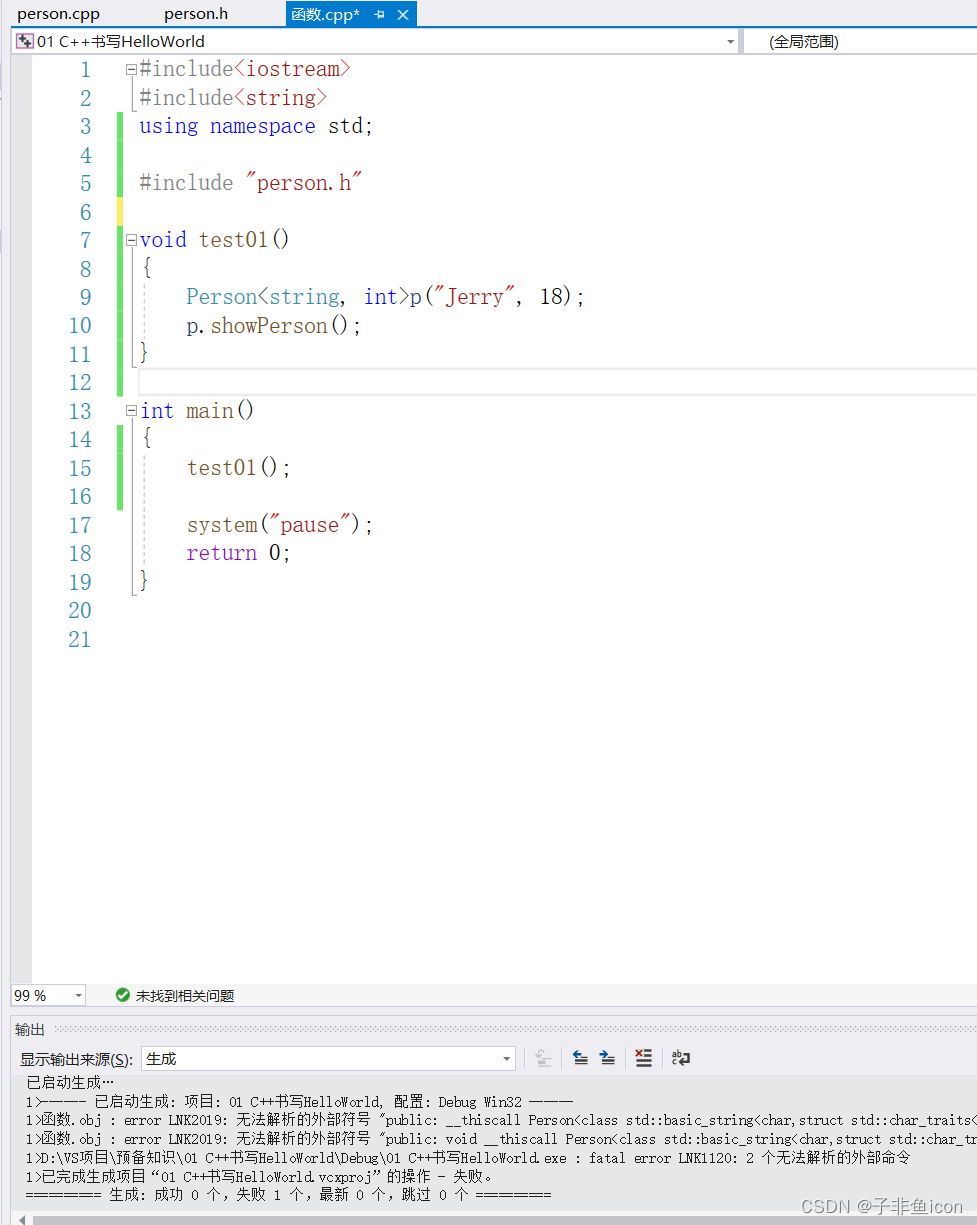
解决:
解决方式1:直接包含.cpp源文件
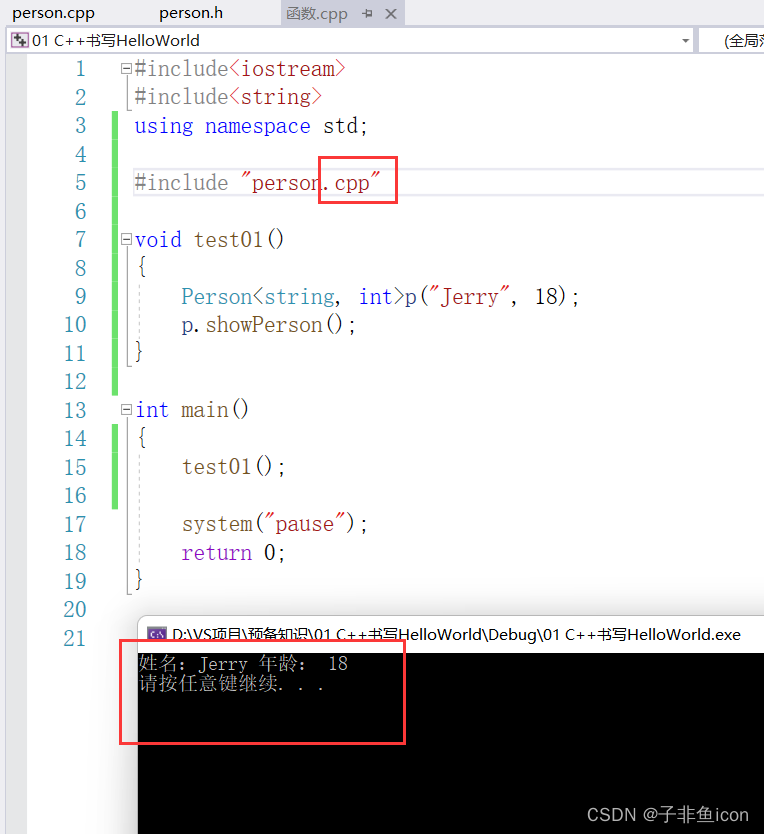
这是因为类模板中的成员函数,一开始是不创建的,这样就导致看不到cpp中的代码。
解决方式2:将声明和实现写到同一个文件中,并更改后缀名为.hpp,hpp是约定的名称,并不是强制
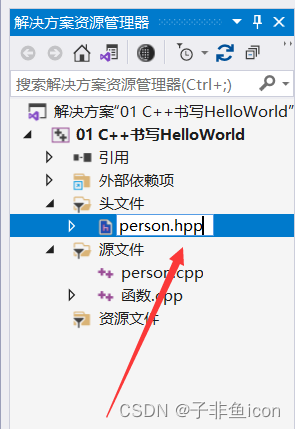

demo13:
person.hpp
#pragma once
#include<iostream>
#include<string>
using namespace std;
template<class T1, class T2>
class Person
{
public:
Person(T1 name, T2 age);
void showPerson();
T1 m_Name;
T2 m_Age;
};
template<class T1, class T2>
Person<T1, T2>::Person(T1 name, T2 age)
{
this->m_Name = name;
this->m_Age = age;
}
//成员函数的类外实现
template<class T1, class T2>
void Person<T1, T2>::showPerson()
{
cout << "姓名:" << this->m_Name << " 年龄: " << this->m_Age << endl;
}
主文件
#include<iostream>
#include<string>
using namespace std;
//第一种解决方式,直接包含 源文件
//#include "person.cpp"
//第二种解决方式,将.h和.cpp中的内容写到一起,将后缀名改为.hpp文件
#include "person.hpp"
void test01()
{
Person<string, int>p("Jerry", 18);
p.showPerson();
}
int main()
{
test01();
system("pause");
return 0;
}
总结:主流的解决方式是第二种,将类模板成员函数写到一起,并将后缀名改为.hpp
1.3.8 类模板与友元
学习目标:
掌握类模板配合友元函数的类内和类外实现
全局函数类内实现 - 直接在类内声明友元即可
全局函数类外实现 - 需要提前让编译器知道全局函数的存在
demo14:
#include<iostream>
#include<string>
using namespace std;
//提前让编译器知道Person类存在
template<class T1, class T2>
class Person;
//类外实现
template<class T1, class T2>
void printPerson2(Person<T1, T2>p)
{
cout << "类外实现-----姓名:" << p.m_Name << " 年龄: " << p.m_Age << endl;
}
//通过全局函数 打印Person信息
template<class T1, class T2>
class Person
{
//全局函数 类内实现
friend void printPerson(Person<T1, T2>p)
{
cout << "类内实现-----姓名:" << p.m_Name << " 年龄: " << p.m_Age << endl;
}
//全局函数 类外实现
//加空模板参数列表
//如果全局函数 是类外实现,需要让编译器提前知道这个函数存在
friend void printPerson2<>(Person<T1, T2>p);
public:
Person(T1 name, T2 age)
{
this->m_Name = name;
this->m_Age = age;
}
private:
T1 m_Name;
T2 m_Age;
};
//1.全局函数在类内实现
void test01()
{
Person<string, int>p("Tom", 20);
printPerson(p);
}
//2.全局函数在类外实现
void test02()
{
Person<string, int>p("Jerry", 18);
printPerson2(p);
}
int main()
{
test01();
test02();
system("pause");
return 0;
}
类内实现-----姓名:Tom 年龄: 20
类外实现-----姓名:Jerry 年龄: 18
总结:建议全局函数做类内实现,用法简单,而且编译器可以直接识别
1.3.9 类模板案例
案例描述: 实现一个通用的数组类,要求如下:
可以对内置数据类型以及自定义数据类型的数据进行存储
将数组中的数据存储到堆区
构造函数中可以传入数组的容量
提供对应的拷贝构造函数以及operator=防止浅拷贝问题
提供尾插法和尾删法对数组中的数据进行增加和删除
可以通过下标的方式访问数组中的元素
可以获取数组中当前元素个数和数组的容量
demo15:
MyArrat.hpp
//自己的通用的数组类
#pragma once
#include<iostream>
#include<string>
using namespace std;
template<class T>
class MyArray
{
public:
//有参构造 参数 容量
MyArray(int capacity)
{
cout << "MyArray有参构造调用" << endl;
this->m_Capacity = capacity;
this->m_Size = 0;
this->pAddress = new T[this->m_Capacity];
}
//拷贝构造
MyArray(const MyArray& arr)
{
cout << "MyArray拷贝构造调用" << endl;
this->m_Capacity = arr.m_Capacity;
this->m_Size = arr.m_Size;
//this->pAddress = arr.pAddress; 浅拷贝
//深拷贝
this->pAddress = new T[arr.m_Capacity];
//将arr中的数据都拷贝过来
for (int i = 0; i < this->m_Size; i++)
{
this->pAddress[i] = arr.pAddress[i];
}
}
//operator==防止浅拷贝问题
MyArray& operator=(const MyArray& arr)
{
cout << "MyArray的operator=调用" << endl;
//先判断原来堆区是否有数据,如果有先释放
if (this->pAddress != NULL)
{
delete[] this->pAddress;
this->pAddress = NULL;
this->m_Capacity = 0;
this->m_Size = 0;
}
//深拷贝
this->m_Capacity = arr.m_Capacity;
this->m_Size = arr.m_Size;
this->pAddress = new T[arr.m_Capacity];
for(int i = 0; i < this->m_Size; i++)
{
this->pAddress[i] = arr.pAddress[i];
}
return *this;
}
//析构函数
~MyArray()
{
if (this->pAddress != NULL)
{
cout << "MyArray的析构调用" << endl;
delete[] this->pAddress;
this->pAddress = NULL;
}
}
private:
T* pAddress; //指针指向堆区开辟的真实数据
int m_Capacity; //数组容量
int m_Size; // 数组大小
};
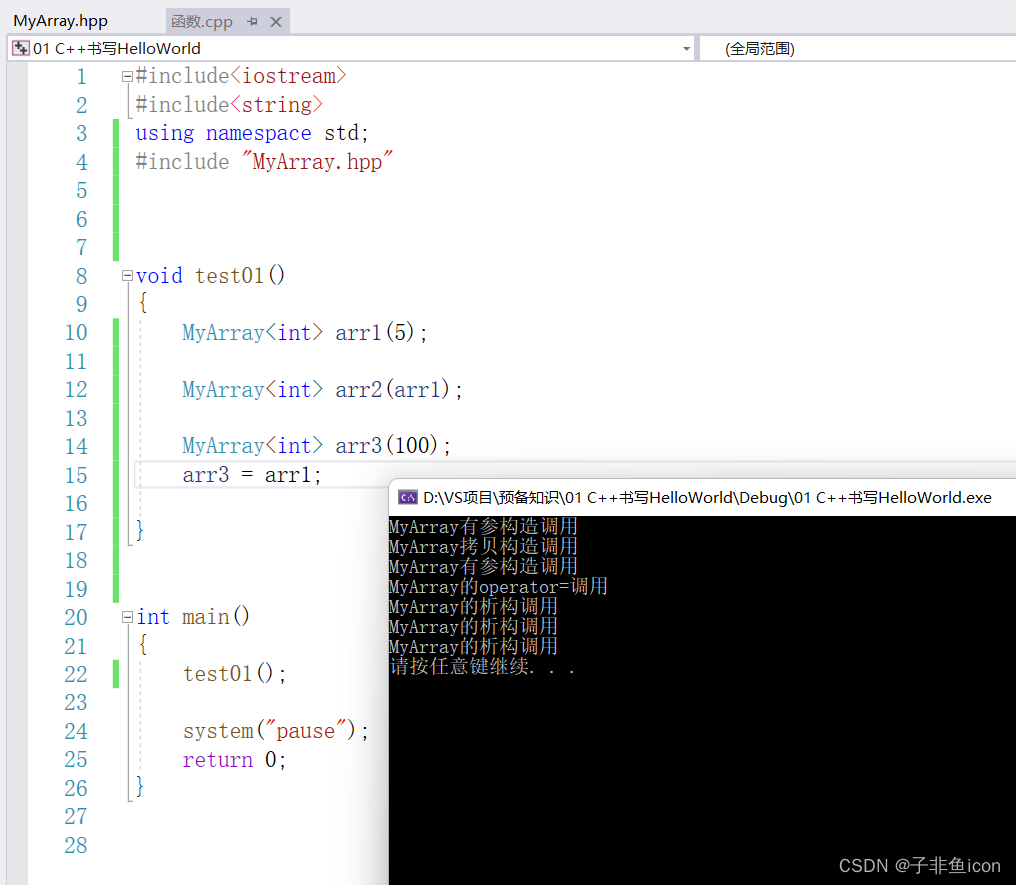
完整案例代码:
MyArray.hpp
//自己的通用的数组类
#pragma once
#include<iostream>
#include<string>
using namespace std;
template<class T>
class MyArray
{
public:
//有参构造 参数 容量
MyArray(int capacity)
{
//cout << "MyArray有参构造调用" << endl;
this->m_Capacity = capacity;
this->m_Size = 0;
this->pAddress = new T[this->m_Capacity];
}
//拷贝构造
MyArray(const MyArray& arr)
{
//cout << "MyArray拷贝构造调用" << endl;
this->m_Capacity = arr.m_Capacity;
this->m_Size = arr.m_Size;
//this->pAddress = arr.pAddress; 浅拷贝
//深拷贝
this->pAddress = new T[arr.m_Capacity];
//将arr中的数据都拷贝过来
for (int i = 0; i < this->m_Size; i++)
{
this->pAddress[i] = arr.pAddress[i];
}
}
//operator==防止浅拷贝问题
MyArray& operator=(const MyArray& arr)
{
//cout << "MyArray的operator=调用" << endl;
//先判断原来堆区是否有数据,如果有先释放
if (this->pAddress != NULL)
{
delete[] this->pAddress;
this->pAddress = NULL;
this->m_Capacity = 0;
this->m_Size = 0;
}
//深拷贝
this->m_Capacity = arr.m_Capacity;
this->m_Size = arr.m_Size;
this->pAddress = new T[arr.m_Capacity];
for(int i = 0; i < this->m_Size; i++)
{
this->pAddress[i] = arr.pAddress[i];
}
return *this;
}
//尾插法
void Push_Back(const T &val)
{
//判断容量是否等于大小
if (this->m_Capacity == this->m_Size)
{
return;
}
this->pAddress[this->m_Size] = val;
this->m_Size++; //更新数组大小
}
//尾删法
void Pop_Back()
{
//让用户访问不到最后一个元素,即为尾删,逻辑删除
if (this->m_Size == 0)
{
return;
}
this->m_Size--;
}
//通过下标方式访问数组中的元素
T& operator[](int index)
{
return this->pAddress[index];
}
//返回数组容量
int getCapacity()
{
return this->m_Capacity;
}
//返回数组大小
int getSize()
{
return this->m_Size;
}
//析构函数
~MyArray()
{
if (this->pAddress != NULL)
{
//cout << "MyArray的析构调用" << endl;
delete[] this->pAddress;
this->pAddress = NULL;
}
}
private:
T* pAddress; //指针指向堆区开辟的真实数据
int m_Capacity; //数组容量
int m_Size; // 数组大小
};
测试代码:
#include<iostream>
#include<string>
using namespace std;
#include "MyArray.hpp"
void printIntArray(MyArray <int>& arr)
{
for (int i = 0; i < arr.getSize(); i++)
{
cout << arr[i] << endl;
}
}
void test01()
{
MyArray<int> arr1(5);
for (int i = 0; i < 5; i++)
{
//利用尾插向数组中插入数据
arr1.Push_Back(i);
}
cout << "arr1的打印输出为:" << endl;
printIntArray(arr1);
cout << "arr1的容量为:" << arr1.getCapacity() << endl;
cout << "arr1的大小为:" << arr1.getSize() << endl;
MyArray<int> arr2(arr1);
cout << "arr2的打印输出为:" << endl;
printIntArray(arr2);
//尾删
arr2.Pop_Back();
cout << "arr2尾删后:" << endl;
cout << "arr2的容量为:" << arr2.getCapacity() << endl;
cout << "arr2的大小为:" << arr2.getSize() << endl;
//MyArray<int> arr2(arr1);
//MyArray<int> arr3(100);
//arr3 = arr1;
}
//测试自定义数据类型
class Person
{
public:
Person() {};
Person(string name, int age)
{
this->m_Name = name;
this->m_Age = age;
}
string m_Name;
int m_Age;
};
void printPersonArray(MyArray<Person>& arr)
{
for (int i = 0; i < arr.getSize(); i++)
{
cout << "姓名:" << arr[i].m_Name << " 年龄:" << arr[i].m_Age << endl;
}
}
void test02()
{
MyArray<Person>arr(10);
Person p1("孙悟空", 999);
Person p2("韩信", 30);
Person p3("妲己", 20);
Person p4("赵云", 25);
Person p5("安其拉", 27);
//将数据插入到数组中
arr.Push_Back(p1);
arr.Push_Back(p2);
arr.Push_Back(p3);
arr.Push_Back(p4);
arr.Push_Back(p5);
//打印数组
printPersonArray(arr);
//输出容量
cout << "arr的容量为:" << arr.getCapacity() << endl;
//输出大小
cout << "arr的大小为:" << arr.getSize() << endl;
}
int main()
{
//test01();
test02();
system("pause");
return 0;
}
二、STL初识
2.1 STL的诞生
长久以来,软件界一直希望建立一种可重复利用的东西
C++的面向对象和泛型编程思想,目的就是复用性的提升
大多情况下,数据结构和算法都未能有一套标准,导致被迫从事大量重复工作
为了建立数据结构和算法的一套标准,诞生了STL
2.2 STL基本概念
STL(Standard Template Library,标准模板库)
STL 从广义上分为: 容器(container) 算法(algorithm) 迭代器(iterator)
容器和算法之间通过迭代器进行无缝连接。
STL 几乎所有的代码都采用了模板类或者模板函数
2.3 STL六大组件
STL大体分为六大组件,分别是:容器、算法、迭代器、仿函数、适配器(配接器)、空间配置器
- 容器:各种数据结构,如vector、list、deque、set、map等,用来存放数据。
- 算法:各种常用的算法,如sort、find、copy、for_each等
- 迭代器:扮演了容器与算法之间的胶合剂。
- 仿函数:行为类似函数,可作为算法的某种策略。
- 适配器:一种用来修饰容器或者仿函数或迭代器接口的东西。
- 空间配置器:负责空间的配置与管理。
2.4 STL中容器、算法、迭代器
容器:置物之所也
STL容器就是将运用最广泛的一些数据结构实现出来
常用的数据结构:数组, 链表,树, 栈, 队列, 集合, 映射表 等
这些容器分为序列式容器和关联式容器两种:
序列式容器:强调值的排序,序列式容器中的每个元素均有固定的位置。 关联式容器:二叉树结构,各元素之间没有
严格的物理上的顺序关系
算法:问题之解法也
有限的步骤,解决逻辑或数学上的问题,这一门学科我们叫做算法(Algorithms)
算法分为:质变算法和非质变算法。
质变算法:是指运算过程中会更改区间内的元素的内容。例如拷贝,替换,删除等等
非质变算法:是指运算过程中不会更改区间内的元素内容,例如查找、计数、遍历、寻找极值等等
迭代器:容器和算法之间粘合剂
提供一种方法,使之能够依序寻访某个容器所含的各个元素,而又无需暴露该容器的内部表示方式。
每个容器都有自己专属的迭代器
迭代器使用非常类似于指针,初学阶段我们可以先理解迭代器为指针
迭代器种类:
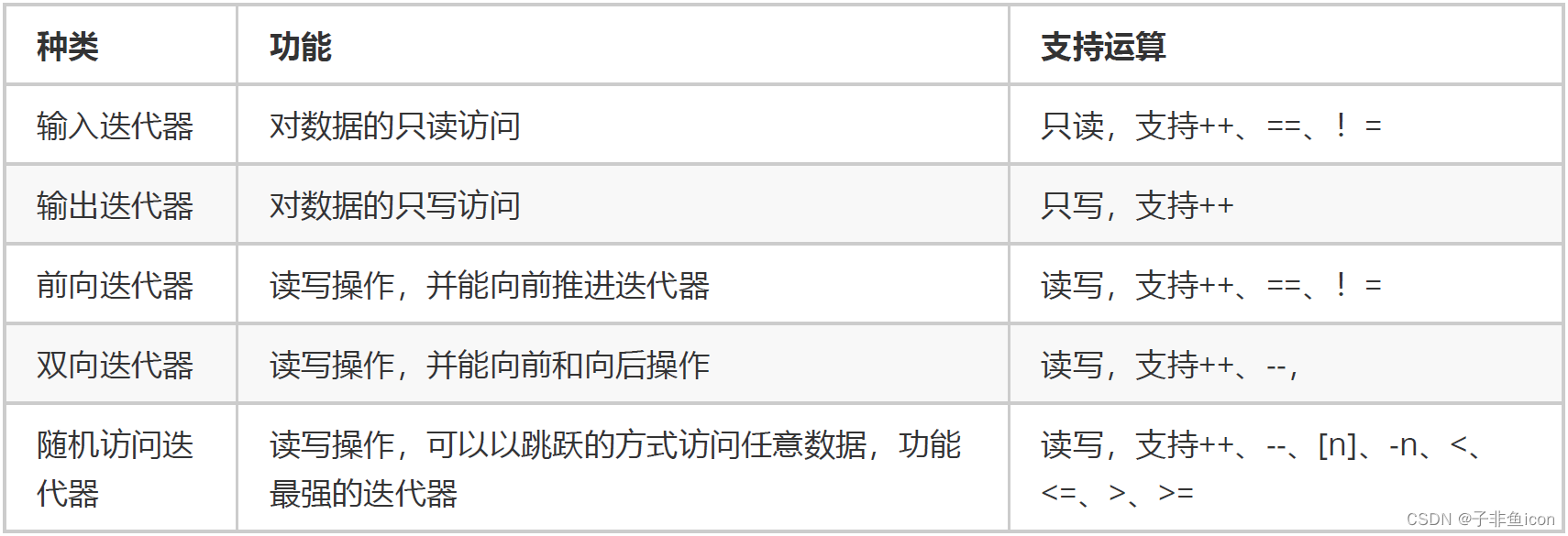
常用的容器中迭代器种类为双向迭代器,和随机访问迭代器
2.5 容器算法迭代器初识
了解STL中容器、算法、迭代器概念之后,我们利用代码感受STL的魅力
STL中最常用的容器为Vector,可以理解为数组,下面我们将学习如何向这个容器中插入数据、并遍历这个容器
2.5.1 vector存放内置数据类型
容器: vector
算法: for_each
迭代器: vector<int>::iterator
demo16:
第一种遍历方式:
#include<iostream>
#include<string>
using namespace std;
#include<vector>
//vector容器存放内置数据类型
void test01()
{
//创建了一个vector容器,数组
vector<int> v;
//向容器中插入数据
v.push_back(10);
v.push_back(20);
v.push_back(30);
v.push_back(40);
//通过迭代器访问容器中的数据
vector<int>::iterator itBegin = v.begin(); //起始迭代器 指向容器中的第一个元素
vector<int>::iterator itEnd = v.end(); //结束迭代器 指向容器中的最后一个元素的下一个位置
//第一种遍历方式
while (itBegin != itEnd)
{
cout << *itBegin << endl;
itBegin++;
}
}
int main()
{
test01();
system("pause");
return 0;
}
10
20
30
40
第二种遍历方式:

第三种遍历方式:
先包含头文件
#include<algorithm> //标准算法的头文件
然后定义myPrint函数:
void myPrint(int val)
{
cout << val << endl;
}
最后利用for_each实现

2.5.2 Vector存放自定义数据类型
学习目标:vector中存放自定义数据类型,并打印输出
demo17:
#include<iostream>
#include<string>
using namespace std;
#include<vector>
#include<algorithm> //标准算法的头文件
//vector容器存放自定义数据类型
class Person
{
public:
Person(string name,int age)
{
this->m_Name = name;
this->m_Age = age;
}
string m_Name;
int m_Age;
};
void test01()
{
vector<Person>v;
Person p1("aaa", 10);
Person p2("bbb", 20);
Person p3("ccc", 30);
Person p4("ddd", 40);
Person p5("eee", 50);
v.push_back(p1);
v.push_back(p2);
v.push_back(p3);
v.push_back(p4);
v.push_back(p5);
for (vector<Person>::iterator it = v.begin(); it != v.end(); it++)
{
//*it解引用出来也是Person类型
//cout << "姓名:" << (*it).m_Name << " 年龄:" << (*it).m_Age << endl;
cout << "姓名:" << it->m_Name << " 年龄:" << it->m_Age << endl;
}
}
//存放自定义数据类型 指针
void test02()
{
vector<Person*>v;
Person p1("aaa", 10);
Person p2("bbb", 20);
Person p3("ccc", 30);
Person p4("ddd", 40);
Person p5("eee", 50);
v.push_back(&p1);
v.push_back(&p2);
v.push_back(&p3);
v.push_back(&p4);
v.push_back(&p5);
for (vector<Person*>::iterator it = v.begin(); it != v.end(); it++)
{
//*it解引用出来是指针
cout << "姓名:" << (*it)->m_Name << " 年龄:" << (*it)->m_Age << endl;
}
}
int main()
{
//test01();
test02();
system("pause");
return 0;
}
姓名:aaa 年龄:10
姓名:bbb 年龄:20
姓名:ccc 年龄:30
姓名:ddd 年龄:40
姓名:eee 年龄:50
2.5.3 Vector容器嵌套容器
学习目标:容器中嵌套容器,我们将所有数据进行遍历输出
demo18:
#include<iostream>
#include<string>
using namespace std;
#include<vector>
#include<algorithm> //标准算法的头文件
//容器嵌套容器
void test01()
{
vector<vector<int>>v;
//创建小容器
vector<int>v1;
vector<int>v2;
vector<int>v3;
vector<int>v4;
//向小容器中添加数据
for (int i = 0; i < 4; i++)
{
v1.push_back(i + 1);
v2.push_back(i + 2);
v3.push_back(i + 3);
v4.push_back(i + 4);
}
//将小容器插入到大容器中
v.push_back(v1);
v.push_back(v2);
v.push_back(v3);
v.push_back(v4);
//通过大容器,把所有数据遍历一遍
for (vector<vector<int>>::iterator it = v.begin(); it != v.end(); it++)
{
//(*it)-----容器 vector<int>
for (vector<int>::iterator vit = (*it).begin(); vit != (*it).end(); vit++)
{
cout << *vit << " ";
}
cout << endl;
}
}
int main()
{
test01();
system("pause");
return 0;
}
1 2 3 4
2 3 4 5
3 4 5 6
4 5 6 7





















 1072
1072











 被折叠的 条评论
为什么被折叠?
被折叠的 条评论
为什么被折叠?








